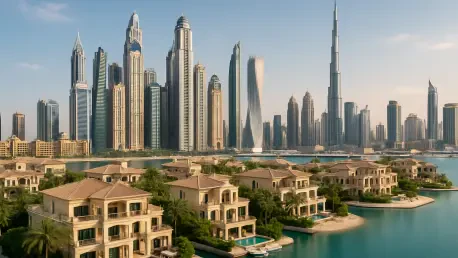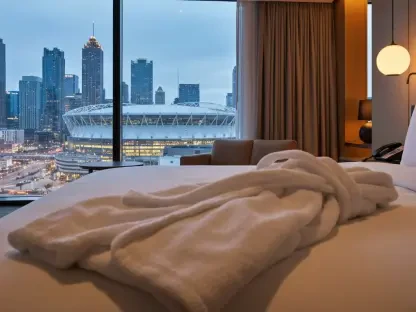Imagine a city where towering skyscrapers and luxurious waterfronts are not just a backdrop but a magnet for global wealth, drawing investors from every corner of the world to participate in a booming market. Dubai’s real estate market stands as a beacon of growth and opportunity in 2025, showcasing remarkable resilience and international allure. The sector is experiencing a surge, driven by an unprecedented wave of tourism, record-breaking sales in both off-plan and high-end properties, and a continuous rollout of ambitious new developments that redefine urban living.
Several factors fuel this dynamic expansion, including a robust tourism industry that bolsters demand for short-term rentals and property investments. The market thrives across diverse segments such as off-plan projects, which dominate transaction volumes, luxury estates that cater to the ultra-wealthy, and mid-market communities appealing to a broader investor base. Major developers play a pivotal role in shaping this landscape, while international buyers flock to secure assets, encouraged by a regulatory environment that prioritizes stability and ease of investment.
Supportive government policies further enhance Dubai’s appeal, creating a framework that fosters confidence among stakeholders. These regulations streamline processes for foreign ownership and provide incentives that attract high-net-worth individuals. As a result, the city solidifies its status as a global hub for real estate, balancing rapid growth with measures that ensure long-term market health and investor protection.
Key Trends and Market Performance in Dubai’s Property Sector
Emerging Dynamics and Buyer Preferences
A notable shift in buyer behavior is shaping Dubai’s property market, often described as a “flight to quality.” Investors and homeowners increasingly prioritize developments that emphasize sustainability, prime locations near key landmarks, and superior build standards. This trend reflects a growing demand for properties that offer not just a place to live but a lifestyle aligned with modern values and long-term value appreciation.
Another significant development is the rising popularity of branded residences, mixed-use projects, and short-term rental options. Branded residences, with nearly 140 active projects, attract global buyers seeking premium amenities and higher returns. Mixed-use developments, integrating residential, retail, and commercial spaces, are also gaining traction, while short-term rentals benefit from a steady stream of tourists, with visitor numbers reaching almost 9.88 million in the first half of this year.
Tourism’s impact cannot be overstated, as it directly influences property demand. High hotel occupancy rates and a constant influx of international visitors create a vibrant market for rental investments. Additionally, opportunities in eco-friendly initiatives and strategic urban planning are emerging as key areas of focus, aligning with evolving consumer preferences for sustainable and well-connected communities.
Market Data and Growth Projections
Delving into the numbers, off-plan sales have captured a dominant 69% of transactions in the first quarter of this year, underscoring strong investor confidence in future developments. Property prices across the city have risen by 3.7% quarter-on-quarter, reaching an average of AED 1,749 per square foot, reflecting sustained demand across various segments. These figures highlight the market’s upward trajectory and its appeal to a diverse buyer pool.
The luxury segment, in particular, has shattered records, with sales of properties valued over US$10 million totaling US$2.6 billion in the second quarter of this year. This unprecedented performance positions Dubai as a leading destination for high-end real estate, drawing affluent buyers seeking exclusivity. Supply projections also paint an optimistic picture, with over 70,000 units expected to be handed over this year and another 133,000 slated for 2026, catering to growing demand.
Looking ahead, while the influx of new units offers abundant choice, it may introduce short-term pricing pressures, especially in the mid-market segment. However, prime and super-prime properties are anticipated to maintain their resilience due to limited availability and unwavering global interest. These trends suggest a market poised for continued growth, provided developers and stakeholders manage supply dynamics effectively.
Challenges Facing Dubai’s Real Estate Expansion
One of the primary hurdles in Dubai’s property market is the risk of oversupply, particularly in the mid-market category. With a significant number of units scheduled for handover in the coming months, there is a potential for pricing pressures as supply outpaces demand in certain areas. This imbalance could temporarily affect investor returns and market sentiment if not addressed strategically.
Affordability remains a concern for specific buyer groups, especially as the volume of new properties increases. While luxury and prime segments cater to high-net-worth individuals, mid-tier buyers may find it challenging to enter the market amid rising costs and abundant options. This disparity highlights the need for tailored financial solutions and diverse offerings to ensure broader accessibility.
Competitive pressures among developers also pose a challenge, necessitating robust financial planning and phased project rollouts to avoid market saturation. Mitigating these risks involves a focus on quality over quantity, incorporating sustainable practices, and targeting international buyers with a penchant for premium assets. Such strategies can help maintain equilibrium and safeguard the market’s long-term stability.
Regulatory Framework and Investor Incentives in Dubai
Dubai’s government has cultivated a regulatory environment that actively supports real estate growth, with policies designed to ease investment processes and encourage global participation. Rules facilitating short-term rentals have proven particularly effective, capitalizing on the city’s status as a tourist hotspot. These measures create a favorable climate for property owners looking to maximize returns through flexible leasing options.
Golden Visa programs stand out as a significant incentive, driving demand for prime and super-prime properties among wealthy individuals seeking residency benefits. This initiative not only boosts sales in the luxury segment but also enhances Dubai’s reputation as a secure and attractive investment destination. The policy’s impact is evident in the growing number of high-value transactions recorded this year.
Urban planning and strict compliance standards further contribute to sustainable development, ensuring that rapid expansion does not compromise quality or investor trust. These regulations strike a balance between fostering growth and protecting stakeholder interests, providing a foundation for confidence in the market. As a result, Dubai continues to attract a diverse pool of investors while maintaining a structured approach to real estate progress.
Future Outlook for Dubai’s Property Market
Transformative projects on the horizon are set to redefine Dubai’s real estate landscape, with developments like Expo Valley’s initial phase of 532 units scheduled for early next year. The relaunch of Palm Jebel Ali, featuring 13.4 kilometers of new shoreline, promises to captivate buyers with unique waterfront offerings. These initiatives underscore the city’s commitment to innovation and its ability to sustain investor interest.
Expo City is emerging as a focal point for European high-net-worth individuals, enhancing Dubai’s global standing in the luxury property arena. This growing appeal, coupled with limited land availability in prime areas, is expected to bolster demand for high-end assets. However, potential supply-demand imbalances in the mid-market could pose challenges, requiring careful monitoring to prevent oversaturation.
Sustainability and innovation remain central to future growth, with branded residences and eco-conscious projects anticipated to lead the way. Global economic trends and tourism will continue to influence market dynamics, shaping investment strategies. Prime locations and integrated developments are likely to dominate as areas of opportunity, ensuring Dubai retains its edge as a premier real estate destination.
Conclusion: Dubai’s Real Estate as a Global Investment Powerhouse
Reflecting on the insights gathered, Dubai’s real estate sector demonstrated exceptional strength through record-breaking off-plan and luxury sales, fueled by a vibrant tourism economy and premium developments that captured global attention. Despite facing short-term hurdles such as pricing pressures in the mid-market, the prime and super-prime segments exhibited unwavering demand, solidifying the city’s allure for affluent investors.
Moving forward, stakeholders should prioritize strategic planning by focusing on high-growth areas like branded residences and sustainable properties to navigate potential oversupply risks. Developers and policymakers must collaborate to ensure phased project rollouts and innovative financial models that address affordability concerns. Emphasizing quality and location will be key to sustaining momentum.
Additionally, leveraging Dubai’s regulatory advantages and tourism appeal can further cement its status as a top-tier investment hub. Investors are encouraged to explore emerging districts and eco-friendly initiatives as pathways to long-term gains. By aligning with these priorities, the market can build on its past successes and chart a resilient course toward continued prominence in global real estate.









